Flag Coat of arms Government Monarchy | Founded 1199 Date dissolved 1349 | |
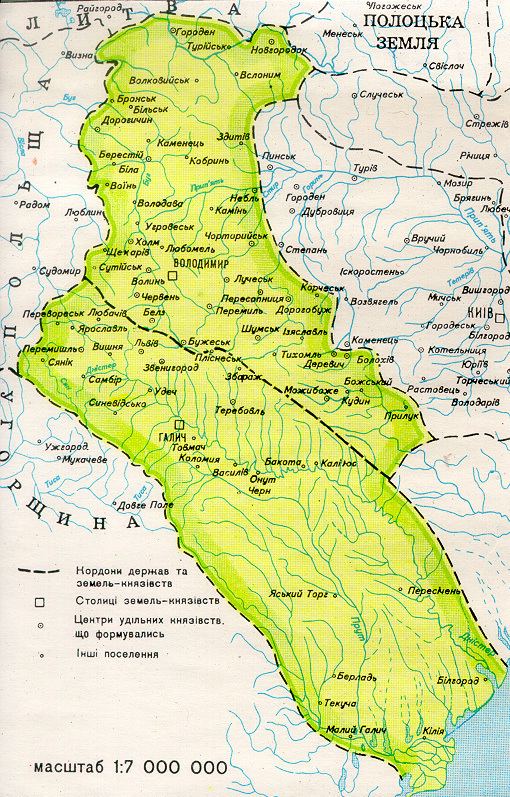 | ||
Religion Eastern Orthodox Christianity Capitals | ||
Kingdom of galicia volhynia
The Principality of Galicia–Volhynia, or Kingdom of Rus' (Old Ruthenian: Галицко-Волинскоє князство, Королѣвство Русь, Ukrainian: Галицько-Волинське князівство, Королівство Русі, Latin: Regnum Galiciae et Lodomeriae, Regnum Russiae), was a state in the regions of Galicia and Volhynia, of present-day Ukraine, that was formed after the conquest of Galicia by the Prince of Volhynia Roman the Great with the help of Leszek the White of Poland. Roman the Great united the principalities of Halych (Galicia) and Volhynia into a state that existed from 1199 to 1349. Along with Novgorod and Vladimir-Suzdal, it was one of the three most important powers to emerge from the collapse of Kievan Rus'.
Contents
- Kingdom of galicia volhynia
- Tribal area
- Rise and apogee
- Decline and fall
- End
- Historical role
- Division
- Temporary
- Rulers
- References
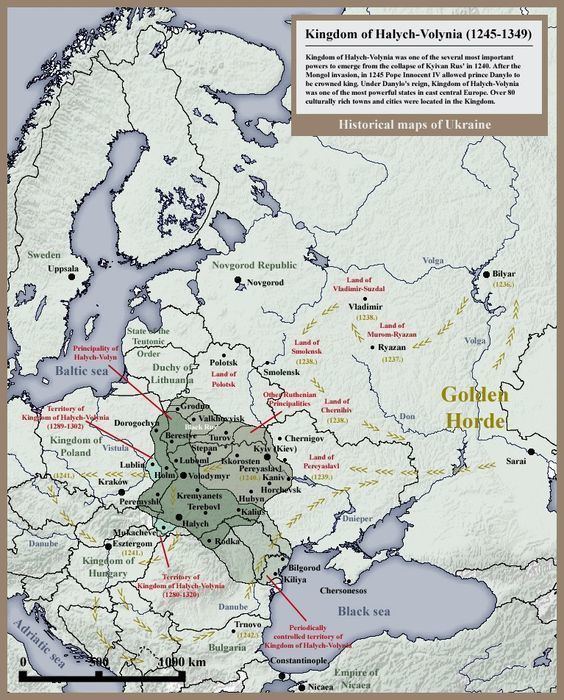
After the enormous destruction wreaked by the Mongol invasion of Kievan Rus' in 1239–41, Prince Danylo Romanovych was forced to pledge allegiance to Batu Khan of the Golden Horde in 1246. He strove to rid his realm of the Mongol yoke, however, by a formal orientation to Western Europe (coronation as a "Rex Rusiae" by a papal legate in 1253) and by attempting, unsuccessfully, to establish military alliances with other European rulers. The Polish conquest of the kingdom in 1349 ended its vassalage to the Golden Horde.

Western Galicia–Volhynia extended between the rivers San and Wieprz in what is now south-eastern Poland, while eastern territories covered the Pripet Marshes (now in Belarus) and upper Southern Bug in modern-day Ukraine. During its time, the kingdom was bordered by Black Rus', the Grand Duchy of Lithuania, the Principality of Turov-Pinsk, the Principality of Kiev, the Golden Horde, the Kingdom of Hungary, the Kingdom of Poland, the Principality of Moldova, and the Monastic State of the Teutonic Knights.
Tribal area
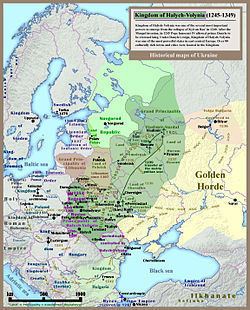
After the fall of the Roman Empire, the area was populated by Slav people, identified with a groups called Buzhans, Dulebes, Croats. Southwestern edge of the land probably was part of Great Moravian state. In year 907 Galician Croats and Dulebs were involved in military campaign against Constantinople led by Rus' Prince Oleg of Novgorod. This is the first significant evidence of political affiliation of native tribes. Around 970 estern edge of this territory was probably included into the Piast dynasty state. The area was mentioned in 981 (by Nestor), when Vladimir the Great of Kievan Rus' took over on his way into Poland. He founded the city of Vladimir (Volynski) and later Christianized the locals. In the 12th century, the Rurikid Principality of Halych was formed there by descendants of Vladimir the Great. It merged at the end of the 12th century with the neighboring Principality of Volhynia into the principality of Galicia–Volhynia, which existed with some breaks for a century and a half.
Rise and apogee
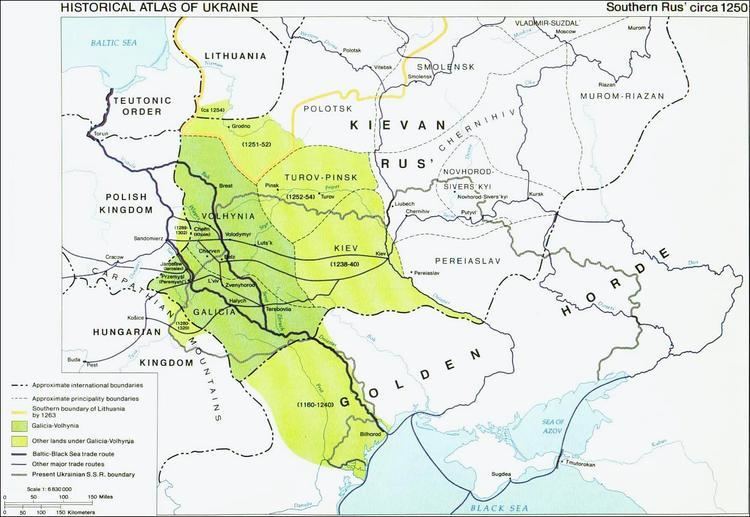
Volhynia and Galicia had originally been two separate Rurikid principalities, assigned on a rotating basis to younger members of the Kievan dynasty. The line of Prince Roman the Great of Vladimir-in-Volhynia had held the principality of Volhynia, while the line of Yaroslav Osmomysl held the Principality of Halych (later adopted as Galicia). Galicia–Volhynia was created following the death in 1198 or 1199 (and without a recognized heir in the paternal line) of the last Prince of Galicia, Vladimir II Yaroslavich; Roman acquired the Principality of Galicia and united his lands into one state. Roman's successors would mostly use Halych (Galicia) as the designation of their combined kingdom. In Roman's time Galicia–Volhynia's principal cities were Halych and Volodymyr-in-Volhynia. In 1204 he captured Kiev. Roman was allied with Poland, signed a peace treaty with Hungary and developed diplomatic relations with the Byzantine Empire. At the height of his reign he briefly became the most powerful of the Rus' princes. He married the niece of the Byzantine emperor Alexios III, for whom Galicia was the main military ally against the Cumans. The relation with Byzantium helped to stabilize Galicia's relations with the Rusian population of the Lower Dniester and the Lower Danube.

In 1205 Roman turned against his Polish allies, leading to a conflict with Leszek the White and Konrad of Masovia. Roman was subsequently killed in the Battle of Zawichost (1205), and his dominion entered a period of rebellion and chaos. Thus weakened, Galicia–Volhynia became an arena of rivalry between Poland and Hungary. King Andrew II of Hungary styled himself rex Galiciæ et Lodomeriæ, Latin for "king of Galicia and Vladimir [in-Volhynia]", a title that later was adopted in the Habsburg Empire. In a compromise agreement made in 1214 between Hungary and Poland, the throne of Galicia–Volhynia was given to Andrew's son, Coloman of Lodomeria, who had married Leszek the White's daughter, Salomea.
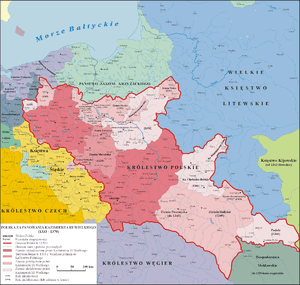
In 1221, Mstislav Mstislavich, son of Mstislav Rostislavich, liberated Galicia–Volhynia from the Hungarians, but it was Daniel Romanovych (Daniel I of Galicia or Danylo Romanovych or Danylo Halytskyi), son of Roman, who formed a real union of Volhynia and Galicia. In 1239 and 1242 he captured Kiev, attempting to become the Grand Prince of all Rus', but he lost the city the first time after a few weeks, the second after a year. Danylo defeated the Polish and Hungarian forces in the battle of Yaroslav (Jarosław) and crushed their ally Rostislav Mikhailovich, son of the prince of Chernigov, in 1245. He also strengthened his relations with Batu Khan by traveling to his capital Saray (Sarai) and acknowledging, at least nominally, the supremacy of the Mongol Golden Horde. After meeting with Batu Khan, Danylo reorganized his army along Mongol lines and equipped it with Mongolian weapons, although Danylo himself maintained the traditional attire of a Rus' prince. Danylo's alliance with the Mongols was merely tactical; he pursued a long-term strategy of resistance to the Mongols.
In 1245, Pope Innocent IV allowed Danylo to be crowned king. Danylo wanted more than recognition, commenting bitterly that he expected an army when he received the crown. Although Danylo promised to promote recognition of the Pope to his people, his realm continued to be ecclesiastically independent from Rome. Thus, Danylo was the only member of the Rurik dynasty to have been crowned king. Danylo was crowned by the papal legate Opizo de Mezzano in Dorohychyn 1253 as the first King of all Rus' (Rex Russiae; 1253–1264). In 1256 Danylo succeeded in driving the Mongols out of Volhynia, and a year later he defeated their attempts to capture the cities of Lutsk and Volodymyr-Volynskyi. Upon the approach of a large army under the Mongolian general Boroldai in 1260, however, Danylo was forced to accept their authority and to raze the fortifications he had built against them.
Under Danylo's reign, Galicia–Volhynia was one of the most powerful states in east central Europe. Literature flourished, producing the Galician–Volhynian Chronicle. Demographic growth was enhanced by immigration from the west and the south, including Germans and Armenians. Commerce developed due to trade routes linking the Black Sea with Poland, Germany, and the Baltic basin. Major cities, which served as important economic and cultural centers, included Lvov (where the royal seat would later be moved by Danylo's son), Vladimir-in-Volhynia, Galich, Kholm (Danylo's capital), Peremyshl, Drohiczyn, and Terebovlya. Galicia–Volhynia was important enough that in 1252 Danylo was able to marry his son Roman to the heiress of the Austrian Duchy in the vain hope of securing it for his family. Another son, Shvarn, married a daughter of Mindaugas, Lithuania's first king, and briefly ruled that land from 1267–1269. At the peak of its expansion, the Galician–Volhynian state contained not only south-western Rus' lands, including Red Rus' and Black Rus', but also briefly controlled the Brodnici on the Black Sea.
After Danylo's death in 1264, he was succeeded by his son Lev, who moved the capital to Lviv in 1272 and for a time maintained the strength of Galicia–Volhynia. Unlike his father, who pursued a Western political course, Lev worked closely with the Mongols, in particular cultivating a close alliance with the Tatar Khan Nogai. Together with his Mongol allies, he invaded Poland. However, although his troops plundered territory as far west as Racibórz, sending many captives and much booty back to Galicia, Lev did not ultimately gain much territory from Poland. Lev also attempted, unsuccessfully, to establish his family's rule over Lithuania. Soon after his brother Shvarn ascended to the Lithuanian throne in 1267, he had the former Lithuanian ruler Vaišvilkas killed. Following Shvarn's loss of the throne in 1269, Lev entered into conflict with Lithuania. From 1274–76 he fought a war with the new Lithuanian ruler Traidenis but was defeated, and Lithuania annexed the territory of Black Ruthenia with its city Navahrudak. In 1279, Lev allied himself with king Wenceslaus II of Bohemia and invaded Poland, although his attempt to capture Kraków in 1280 ended in failure. That same year, Lev defeated Hungary and annexed part of Transcarpathia, including the city of Mukachevo. In 1292 he defeated Poland and added Lublin with surrounding areas to the territory of Galicia–Volhynia.
Decline and fall
After Lev's death in 1301, a period of decline ensued. Lev was succeeded by his son Yuri I, who ruled for only seven years. Although his reign was largely peaceful and Galicia–Volhynia flourished economically, Yuri I lost Lublin to the Poles in 1302 and Transcarpathia to the Hungarians. From 1308 until 1323 Galicia–Volhynia was jointly ruled by Yuri I's sons Andrew and Lev II, who proclaimed themselves to be the kings of Galicia and Volhynia. The brothers forged alliances with King Władysław I of Poland and the Teutonic Order against the Lithuanians and the Mongols, but the Kingdom was still tributary to the Mongols and joined the Mongol military expeditions of Uzbeg Khan and his successor, Janibeg Khan. The brothers died together in 1323, in battle, fighting against the Mongols, and left no heirs.
After the extinction of the Rurikid dynasty in Galicia–Volhynia in 1323, Volhynia passed into the control of the Lithuanian prince Liubartas, while the boyars took control over Galicia. They invited the Polish prince Boleslaw Yuri II, a grandson of Yuri I, to assume the Galician throne. Boleslaw converted to Orthodoxy and assumed the name Yuri II. Nevertheless, suspecting him of harboring Catholic feelings, the boyars poisoned him in 1340 and elected one of their own, Dmitry Detko, to lead the Galician state. In Winter 1341 Tatars, Ruthenians led by Detko, and Lithuanians led by Liubartas were able to defeat the Poles, although they were not so successful in Summer 1341. Finally, Detko was forced to accept Polish overlordship, as a starost of Halych. After Detko's death, Poland's King Casimir III mounted a successful invasion, capturing and annexing Galicia in 1349. Galicia–Volhynia ceased to exist as an independent state.
Danylo's dynasty attempted to gain support from Pope Benedict XII and broader European powers for an alliance against the Mongols, but ultimately proved unable to compete with the rising powers of the centralised Grand Duchy of Lithuania and the Kingdom of Poland. Only in 1349, after the occupation of Galicia–Volhynia by an allied Polish-Hungarian force, was the Kingdom of Galicia–Volhynia finally conquered and incorporated in Poland. This ended the vassalage of Galicia–Volhynia Rus' to the Golden Horde.
End
From 1340 to 1392 the civil war in the region transitioned into a power struggle between Lithuania, Poland, and Hungary. The first stage of conflict led to the signing of a treaty in 1344 that secured the Principality of Peremyshl for the Crown of Poland, while the rest of the territory belonged to a member of the Gediminis family, Liubartas. Eventually by the mid-14th century, the Kingdom of Poland and the Grand Duchy of Lithuania divided up the region between them: King Casimir III took Galicia and Western Volhynia, while the sister state of Eastern Volhynia together with Kiev came under Lithuanian control, 1352–66.
After 1352 most of the Ruthenian Voivodeship belonged to the Crown of the Polish Kingdom, where it remained also after the Union of Lublin between Poland and Lithuania. The present-day town of Halych is situated 5 kilometres (3.1 mi) away from the ancient capital of Galicia, on the spot where the river port of the old town was located, and where King Liubartas of Galicia–Volhynia constructed a wooden castle in 1367.
By the treaty of the Union of Lublin of 1569, all of the former principality of Galicia–Volhynia became part of Poland. In 1772, Empress Maria Theresa of Austria (who was also Queen of Hungary) revived the old Hungarian claims to the Kingdom of Galicia and Lodomeria (Regnum Galiciæ et Lodomeriæ), using them to justify the participation of Austria in the partitions of Poland.
Historical role
The Galician-Volhynian Chronicle reflected the political programme of the Romanovich dynasty ruling Galicia–Volhynia. Galicia–Volhynia competed with other successor states of Kievan Rus' (notably Vladimir-Suzdal) to claim the Kievan inheritance. According to the Galician–Volhynian Chronicle, Galicia–Volhynia's King Daniil was the last ruler of Kiev preceding the Mongolian invasion and thus Galicia–Volhynia's rulers were the only legitimate successors to the Kievan throne. Until the end of Galician-Volhynian state, its rulers advanced claims upon "all the land of Rus'." The seal of King Yuri I contained the Latin inscription domini georgi regis rusie.
In contrast to their consistent secular or political claims to the Kievan inheritance, Galicia's rulers were not concerned by religious succession. This differentiated them from their rivals in Vladimir-Suzdal, who sought to, and attained, control over the Kievan Church. Rather than contest Vladimir-Suzal's dominance of the Kievan Church, Galicia-Volhynia's rulers merely asked for and obtained a separate Church from Byzantium.
Galicia–Volhynia also differed from the northern and eastern principalities of the former Kievan Rus' in terms of its relationship with its western neighbors. King Danylo was alternatively an ally or a rival with neighboring Slavic Poland and partially Slavic Hungary. According to historian George Vernadsky, Galicia–Volhynia, Poland and Hungary belonged to the same psychological and cultural world. The Roman Catholic Church was seen as a neighbor and there was much intermarriage between the princely houses of Galicia and those of neighboring Catholic countries. In contrast, the Westerners faced by Alexander, prince of Novgorod, were the Teutonic Knights, and the northeastern Rus' experience of the West was that of hostile crusaders rather than peers.
